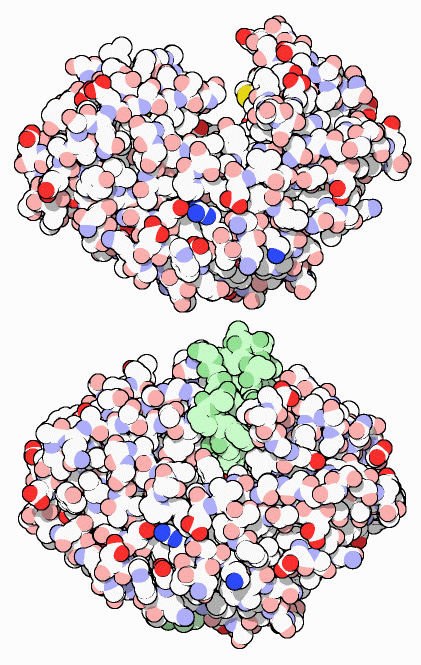|
Inhaltsübersicht | Nanomaschinen | Moleküle | Programme | Kurse | Fun | Links |
||
| > |
Pepsin
Holiday Treats
During the holiday season, we often place greater demands on our digestive enzymes than at other times of the year. Our digestive system contains a host of tough, stable enzymes designed to seek out those rich holiday treats and break them into small pieces. Pepsin is the first in a series of enzymes that digest proteins. In the stomach, protein chains bind in the deep active site groove of pepsin, seen in the upper illustration (from PDB entry 5pep), and are broken into smaller pieces. Then, a variety of proteases and peptidases in the intestine finish the job. The small fragments--amino acids and dipeptides--are then absorbed by cells for use as metabolic fuel or construction of new proteins.
A Tricky Business
Enzymes that digest proteins pose a real challenge. The enzyme must be constructed inside the cell, but controlled in some manner so that it doesn't immediately start digesting the cell's own proteins. To solve this problem, pepsin and many other protein-cutting enzymes are created as inactive "proenzymes," which may then be activated once safely outside the cell. Pepsin is constructed with an extra 44 amino acids, shown in green in the lower illustration (from entry 3psg), which block the large active site groove and hobble the enzyme. In the stomach, this extraneous chain is clipped off and the enzyme begins its destructive campaign.
A Piece of Scientific History
For several reasons, digestive enzymes are attractive candidates for scientific study. They are easily isolated and present in large amounts in digestive juices. They are also extraordinarily stable, because they perform their jobs under the harsh conditions present in the digestive system. The reactions catalyzed by digestive enzymes are also easily followed: you can add them to a protein such as gelatin and watch it lose its gel-like consistency. In the 18th century, pepsin was the first enzyme to be discovered, and later, pepsin was the second enzyme to be crystallized (after urease). These crystals played an important role in showing that enzymes were proteins and that they had a defined structure. Today, the structure of pepsin, determined from similar crystals, is available in PDB entry 5pep and several others.
Next: Acid Proteases
Last changed by: A.Honegger,
